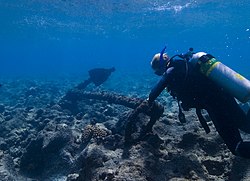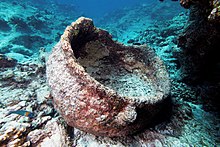Two Brothers (ship)
{{WikidataCoord}} – malformed coordinate data
 A diver examines an anchor at the Two Brothers shipwreck site on August 24, 2008.
| |
| History | |
|---|---|
| Name | Two Brothers |
| Out of service | February 11, 1823 |
| Fate | Sank near French Frigate Shoals, February 11, 1823 |
| General characteristics | |
| Class and type | Nantucket whaler |
| Tons burthen | 217 (bm)[1] |
Two Brothers was a Nantucket whaleship that sank on the night of February 11, 1823, off the French Frigate Shoals. The ship's captain was George Pollard, Jr., former captain of the famous whaleship Essex. The wreck was discovered in 2008 (announced on February 11, 2011) by a team of marine archaeologists working on an expedition for the National Oceanic and Atmospheric Administration in the Papahānaumokuākea Marine National Monument.[2][3][4] She is thought to have been built in 1804 by Joseph Glidden in Hallowell, Maine.[5]
Whaling voyages
[edit]On her first whaling voyage, Two Brothers left Nantucket on 21 November 1818, with George B. Worth, master. On March 5, 1821, the ship encountered fellow Nantucket whaleship Dauphin which on February 23 had rescued Captain George Pollard Jr. and crewman Charles Ramsdell who were on a whaleboat from the whaleship Essex which had sunk after being rammed twice by a sperm whale. Pollard, captain of the Essex, and Ramsdell were in poor mental health (dissociative) after 93 days at sea in the whaleboat. They were transferred to Two Brothers which was heading to Valparaíso, Chile.
Two Brothers returned on 5 August 1821 from the Pacific with 1231 barrels of sperm oil and 158 barrels of whale oil.[6][7]
On her second whaling voyage, Two Brothers left Nantucket on 13 November 1821,[7] with Captain George Pollard Jr., master, and with destination the Pacific.[6]
Wreck
[edit]On the night of February 11, 1823—while sailing west through the Northwestern Hawaiian Islands with another whaling ship, Martha—Two Brothers found herself in a storm. The two ships became separated and Captain Pollard of Two Brothers was unclear as to his ship's position. Soon, Two Brothers grounded and sank on a reef near French Frigate Shoals. Captain Pollard did not want to abandon ship but his crew pleaded with him and they clung to small boats through the night. The next morning, they were rescued by Martha.[8][9]
Thomas Nickerson, who served as boatsteerer on Two Brothers, wrote about the wreck. Nickerson had also served with Pollard on the Essex and survived its sinking. Nickerson's account is preserved in a manuscript titled "Loss of the Ship Two Brothers of Nantucket" (MS 106 F3.5) in the collections of the Nantucket Historical Association.[10]
Two Brothers reef Mystery
[edit]
The wrecking of the ship caused the creation of an idea that there was newly discovered reef, which for decades was noted as Two Brothers reef near the French Frigate Shoals. There was some discussion about this and both Nickerson and Derrick thought this was a misidentification of the French Frigate Shoals, not a new reef.[11] The mentioning of the Two Brothers reef was stopped in 1931 when that area was surveyed and no reef was found, and the identification of the Two Brothers wreck on the French Frigate Shoals further confirms the earlier suspicion that the French Frigate Shoals had been misidentified as a new reef due to a navigational mistake.[12]
“We have not seen a vestige of our ill-fated ship nor haven’t heard what a vestige of her has ever been seen since. I believe this reef has been claimed as a new discovery, but although our reckoning places its position one degree of Latitude to the northward and three degrees to the westward, still I believe with Captain Derrick that it is no other than the French Frigate Shoals and that our navigations were mistaken the more so as I remember that owing to thick weather we had been several days without observation.”
— Thomas Nickerson as quoted by A Sounding Lead on a Distant Reef, Captain Pollard’s Lessons Learned [12]
Discovery
[edit]
The wreck of Two Brothers was discovered in 2008 by a team of marine archaeologists working on an expedition for the National Oceanic and Atmospheric Administration (NOAA). The identity of the ship was not immediately known so it was called the "Shark Island Whaler"; the ship's identification as Two Brothers was announced by NOAA on February 11, 2011, the 188th anniversary of her sinking.[1] The wreck is the first discovery of a wrecked Nantucket whaling ship.[9]
Although identifying it as 19th century whaler was indicated by the anchor and various whaling tools such as trypots, there were three such whalers known to have wrecked at the French Frigate Shoals.[13] This included the Two Brothers, but also the South Seaman and the Daniel Wood.[14] The Two Brothers wrecked in 1823, the South Seaman in 1859, and the Daniel Wood in 1867.[13]
Some of the first artifacts found at the wreck site include two anchors, three try pots, bricks, and the remains of the ship's rigging. Expeditions in 2009 and 2010 turned up more artifacts including blubber hooks, five harpoon tips, three whaling lances, four cast-iron cooking pots and ceramics and glass.[9]
The shipwreck site was listed on the National Register of Historic Places in 2017.
References
[edit]![]() This article incorporates public domain material from websites or documents of the National Oceanic and Atmospheric Administration.
This article incorporates public domain material from websites or documents of the National Oceanic and Atmospheric Administration.
- ^ a b Kelly, Gleason; Raupp, Jason T. (2010). "Lost & Found: In Papahānaumokuākea Marine National Monument: The Possible Wreck Site of the Nantucket Whaleship Two Brothers". Historic Nantucket. 60 (3): 13–17. ISSN 0439-2248.
- ^ "News Release: Lost Whaling Shipwreck with Link to Melville's Moby-Dick Discovered in the Northwestern Hawaiian Islands" (PDF). Papahānaumokuākea Marine National Monument. February 11, 2011. Retrieved February 12, 2011.
- ^ McKinley, Jesse (February 11, 2011). "No 'Moby-Dick': A Real Captain, Twice Doomed". New York Times. Retrieved February 12, 2011.
- ^ "'Moby Dick' captain's ship found". BBC Online. February 12, 2011. Retrieved February 12, 2011.
- ^ Keogh, Kelly. "National Register of Historic Places Registration Form" (PDF). dlnr.hawaii.gov. p. 5. Retrieved April 3, 2020.
- ^ a b "National Maritime Digital Library, American Offshore Whaling Voyages: A Database - Two Brothers". Retrieved April 14, 2021.
- ^ a b Catalogue of Nantucket Whalers: And Their Voyages from 1815 to 1870. Nantucket, MA: Hussey & Robinson. 1876. pp. 11 & 15.
- ^ Philbrick, Nathaniel (2001). In the Heart of the Sea: The Tragedy of the Whaleship Essex. New York: Penguin. pp. 208–210. ISBN 978-0-14-100182-1. OCLC 46949818.
- ^ a b c "Lost Whaling Shipwreck with Link to Melville's Moby-Dick Discovered in the Northwestern Hawaiian Islands". National Oceanic and Atmospheric Administration. February 11, 2011. Retrieved February 13, 2011.
- ^ Simons, Ben (2010). "Thomas Nickerson's Account of the Wreck of the Two Brothers". Historic Nantucket. 60 (3): 12. ISSN 0439-2248.
- ^ Gleason, Kelly. "A Sounding Lead on a Distant Reef, Captain Pollard's Lessons Learned". Retrieved April 14, 2021.
- ^ a b "A Sounding Lead on a Distant Reef, Captain Pollard's Lessons Learned".
- ^ a b "Papahānaumokuākea Marine National Monument".
- ^ "Papahānaumokuākea Marine National Monument". www.papahanaumokuakea.gov. Retrieved April 14, 2021.
External links
[edit]- Maritime incidents in February 1823
- Shipwrecks in the Pacific Ocean
- Tall ships of the United States
- Whaling ships
- 1810s ships
- Whaling in the Hawaiian Kingdom
- 2008 archaeological discoveries
- Archaeological sites on the National Register of Historic Places in Hawaii
- Shipwrecks on the National Register of Historic Places
- French Frigate Shoals
- Ships built in Nantucket, Massachusetts



